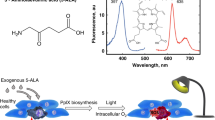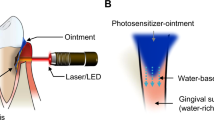Abstract
Sulphonated phthalocyanines are studied as photosensitizers for photodynamic therapy of cancer. Their strong fluorescence and tumour-localising properties make them also potentially useful for detection of cancer by fluorescence. For this purpose, we have studied the fluorescence kinetics and localisation of aluminum phthalocyanine disulphonate (AlPcS2) in 4-nitroquinoline 1-oxide (4NQO)-induced dysplasia and invasive cancer of the oral mucosa of the hard palate in Wistar albino rats. Twenty-two rats were divided into six groups. Five groups were subjected to a 4NQO application period of 8, 12, 16, 20 or 26 weeks and one was a control group. The dysplasia varied from slight to severe and was correlated with the duration of the application period. All animals received a dose of 1 micromol/kg AlPcS2 i.v. Fluorescence images were recorded via a specially designed 'palatoscope' with excitation at 460 +/- 20 nm for autofluorescence, 610 +/- 15 nm for AlPcS2 fluorescence and detection of emission at 675 +/- 15 nm. After subtraction of the two images the specific AlPcS2 fluorescence remained. AlPcS2-mediated fluorescence increased significantly when the severity of dysplasia increased (P<0.04). Also the phenomenon of strong fluorescent spots on the fluorescence images was observed. This always occurred within the first 10 h after injection of AlPcS2. Histological analysis showed a local alteration to a mucosa in 67% of these spots, which was either invasive cancer (29%) or inflammation (38%). These results suggest two different mechanisms of AlPcS2 uptake in tissue, one associated with the presence of generalised dysplasia and another associated with local changes of the epithelial/connective tissue, which is not necessarily specific for tumours.
This is a preview of subscription content, access via your institution
Access options
Subscribe to this journal
Receive 24 print issues and online access
$259.00 per year
only $10.79 per issue
Buy this article
- Purchase on Springer Link
- Instant access to full article PDF
Prices may be subject to local taxes which are calculated during checkout
Similar content being viewed by others
Author information
Authors and Affiliations
Rights and permissions
About this article
Cite this article
Witjes, M., Speelman, O., Nikkels, P. et al. In vivo fluorescence kinetics and localisation of aluminium phthalocyanine disulphonate in an autologous tumour model. Br J Cancer 73, 573–580 (1996). https://doi.org/10.1038/bjc.1996.100
Issue Date:
DOI: https://doi.org/10.1038/bjc.1996.100
This article is cited by
-
In vivo quantification of photosensitizer fluorescence in the skin-fold observation chamber using dual-wavelength excitation and NIR imaging
Lasers in Medical Science (2011)
-
Photofrin-mediated photodynamic therapy of rat palatal mucosa: Normal tissue effects and light dosimetry
Lasers in Medical Science (1996)



